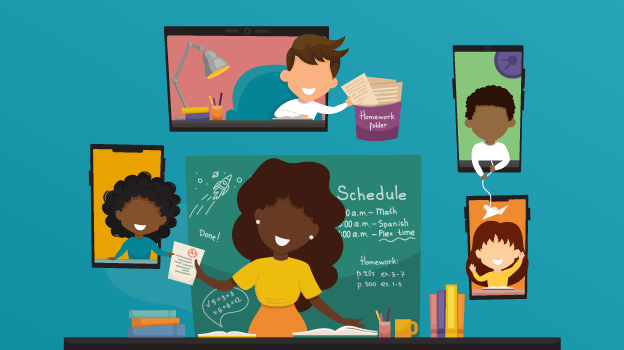
9 Easy mindfulness activities for the virtual classroom
These are challenging times for anyone, including students. The mindfulness-based intervention shows promise in the improvement of cognitive performance, classroom behavior, and student focus. A tiny change in their routine — like mindfulness — can have a rippling positive effect on their overall wellness.
Mindfulness can also be a part of the virtual classroom, given that school is likely to continue in an online format. The easiest way to start a mindfulness practice is to incorporate short and easy techniques in everyday lessons. No equipment, money, or apps are needed.
Let’s see how:
-
Just listen
A great icebreaker exercise is to ask students to relax, sit in a comfortable position of their choice (legs crossed, lying down) and just have them listen to the sounds in their rooms for a minimum of 30 seconds. The trick here is to get them to sit still and become aware of their surroundings. It’s OK if it’s not perfect from the beginning.
-
Easy meditation technique
Ask your students to sit comfortably and start by being aware of how they feel in the present moment. Then, invite them to breathe in deeply and exhale, imagining that their belly is a balloon that inflates and deflates. It’s OK if they don’t get it right away, as it can take some practice, but even a few minutes can help them clear their minds.
-
Belly breathing
In this diaphragm breathing exercise, instruct students to place a hand on their belly and feel it expanding and contracting, shoulders relaxed. Take a deep breath for five seconds and release for three, do it again for a few minutes. This exercise can be done anywhere, while they wait for a bus or before going to sleep.
-
Alternate nostril breathing
Using one hand, instruct them to place the thumb and ring finger on one nostril at a time. Gently put pressure on the right nostril and inhale through the left nostril, then release without exhaling. Close the left nostril with your finger and exhale through the right nostril, and repeat. That is a basic Pranayama technique.
-
Sensory experiences
There’s no secret that sensory experiences enhance learning and that they’re hugely beneficial for children’s overall development. Simply ask students to choose an item, be it a tennis ball, slime, playdoh, etc. They get to hold the object in their hands and describe or think about what they’re experiencing: texture, color, smells, etc.
-
Guided storytelling
This activity is excellent for introducing a new lesson or concept. For example, during a biology class, ask students to close their eyes, get in a comfortable position, and just listen as you describe a long walk through the forest. Guided by your voice, they can imagine walking through a path, the types of plants or animals they can find there, the sounds, etc.
-
Finger tracing exercise
This intuitive exercise is for beginners who don’t know yet how to slow their breathing. Students take one hand and fan it out as if they were trying to trace it on paper. Then, using their other hand, they trace slowly along, one finger at a time. Starting with the thumb, trace the outside and inhale, then trace the inside and exhale. Repeat with all fingers.
-
Get up and move
A lot of seat time has downsides such as muscle pain, especially in the upper and lower back areas. This exercise is a fun way to end an online lesson or even incorporate into asynchronous classes. Instruct students to take three minutes to do squats, jumping jacks, use hula hoops or steps to move. If you’re on a video call, do it together with them!
-
Knowledge is power
For younger students, activities centered around identifying emotions can be a powerful experience. Instruct them to draw smiley or frowny faces and show you or others what they’re experiencing at the moment. For older students, design a mini-lesson centered around the brain’s response to stress and how to calm their minds.
-
Bonus tip: mindfulness in self-paced lessons
The ultimate goal is for students to use these techniques on their own and use them willingly. Before starting a new module or lesson in your learning management system, you can add a video or a short description of a mindfulness exercise in the introduction. The same goes for any task that might trigger a stress response, such as taking an online exam.
Visit our Blog for insightful posts on edtech for K-12 and Higher Ed.







